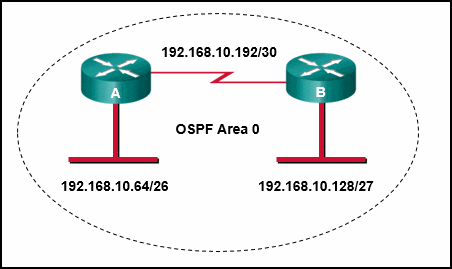Refer to the exhibit. Which sequence of commands should be used to configure router A for OSPF?

- router ospf 1
network 192.168.10.64 0.0.0.63 area 0
network 192.168.10.192 0.0.0.3 area 0 - router ospf 1
network 192.168.10.0 - router ospf 1
network 192.168.10.64 255.255.255.192
network 192.168.10.192 255.255.255.252 - router ospf 1
network 192.168.10.0 area 0
| Explanation & Hint:
To configure router A for OSPF with the network addresses shown in the exhibit, you’d need to use the following sequence of commands:
network 192.168.10.64 0.0.0.63 area 0 network 192.168.10.192 0.0.0.3 area 0 Here’s the breakdown:
The other sequences of commands have either incomplete network statements, missing area designations, or incorrect wildcard masks. |